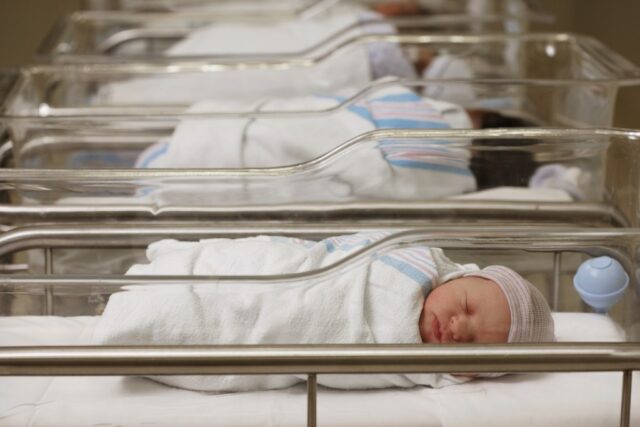President Donald Trump, a father of five who dubbed himself the “fertilization president” during Women’s History Month, has reportedly begun to float potential incentives to bring up the U.S. birth rate. Elon Musk, one of his closest advisers, has at least a dozen children and has said that his fear of low birth rates leading to the collapse of modern civilization keeps him up at night.
For years, people concerned about falling birth rates have warned of the economic consequences of population decline. When a country falls below replacement-level fertility, its aging population will surpass the new, younger generation, shrinking the labor force and straining the national economy with increased costs of elder care, retirement benefits and medical services.
But increasing a country’s birth rate is a heavy lift — if it’s possible at all, experts tell PBS News.
The Centers for Disease Control and Prevention defines birth rate as the number of live births in a given year per 1,000 people in the population. Fertility rate more specifically refers to the number of births among “women of reproductive age.”
Fertility rates are a stronger indicator of population patterns over time, whereas it can be difficult to derive long- or medium-term patterns from birth rates, says Jennifer Sciubba, president and CEO of the Population Reference Bureau.
The commonly accepted replacement fertility rate in developed countries for maintaining the population — that is, not growing or shrinking — is an average of 2.1 children per person who can give birth. After years of decline, the U.S. total fertility rate hit a historic low of 1.6 in 2023, according to a CDC report.
However, according to Sciubba, 1.6 is still “somewhat on the higher end” compared to other developed countries. She says declining fertility rates are trending across the world, “regardless of country income level, geography or culture.”
In fact, more than two-thirds of the global population live in an area that is below replacement-level fertility, according to a United Nations report on fertility released Friday. The U.N. also found that the average global fertility rate in 2024 was 2.2 births per woman, down from 3.3 in 1990.
WATCH: Endometriosis affects millions, but can take years to diagnose. Here’s what to know
The U.S. fertility rate has been following this trend and decreasing since the Great Recession, despite birth rates typically rising after a recession ends, according to Karen Benjamin Guzzo, director of the Carolina Population Center at the University of North Carolina at Chapel Hill.
She attributes this decline to teenagers and young adults having fewer children, “driven primarily by better access to contraception.”
“It’s a good news story,” she says, one that often gets lost in existential anxieties about the decline of the American population.
That fear is driving the Trump administration’s pushes for a baby boom as it considers a slew of policies in hopes of increasing the U.S. birth rate.
The New York Times reported that some of those policies include reserving 30 percent of Fulbright scholarships for applicants who are married or parents, awarding a “National Medal of Motherhood” to mothers of six or more children and federally funding education on women’s menstruation and ovulation.
PBS News spoke to experts for a closer look at what the research says about the effect of government policies on birth rates — and whether increasing fertility rates is even a worthwhile goal.
Cash for babies
One of the reported Trump proposals is a $5,000 cash “baby bonus” to new mothers after delivery.
A $5,000 bonus, however, will “not budge fertility rates” because “it’s not enough money,” says Guzzo.
“Who doesn’t want $5,000? But it’s not gonna be like, ‘Oh, I’m gonna have a kid now because I get this money,’” Guzzo said. “I mean, what it really might do is push people who are like, ‘I was gonna have a kid next year, but now I can have one this year.’”
Many countries have already trialed this method — whether it’s giving a one-time lump sum, recurring payments or a combination of both to new parents — and found little success in increasing the birth rate, even with higher stipends. While researchers have pointed to improved health and economic outcomes in similar cash payment pilots, developed countries do not typically see cash bonuses increase birth rates in the long term.
For example, Singapore offers the equivalent of around $8,500 per child for first- and second-born children, and $10,000 for three or more children, split up into twice-a-year payments over the first six and a half years of a child’s life. Germany issues up to $335 in monthly child allowance for qualifying parents.
Both countries are still below replacement-level fertility.
“The one-time bonuses are definitely not very effective, and that’s pretty widely shown,” Guzzo said.
Children are just really expensive, said Sarah Hayford, director of the Institute for Population Research at the Ohio State University. The most recent report from the U.S. Department of Agriculture found that a decade ago, raising a child cost a middle-income American family with married parents more than $230,000 from birth through age 17, though that number varied widely depending on geography, family income level and number of children, among other factors.
“I don’t think it’s realistic to think that any amount of money that the government could plausibly give out would be enough to really address the costs of raising a child,” she said.
Child care
A policy that may be more effective in increasing birth rates is lowering or completely eliminating the costs of child care, one of the most prohibitive barriers to having children.
On average, U.S. families spend up to 16 percent of their income on full-day care for one child, with median annual prices ranging from $6,552 to $15,600 in 2022, according to data from the U.S. Department of Labor. Additionally, more than half of American children live in a child care desert, meaning there are critical shortages of child care options. Day care waitlists can stretch to several months or even years.
“Probably the thing that is most likely to have the impact on birth rates is adequate child care,” Guzzo said.
A 2024 paper in the journal Population and Development Review that analyzed studies on child care policies found an overall positive impact of these policies on fertility. This is especially true for younger children and more highly-educated parents.
Studies have shown that improved parental leave policies and increased access to cheap or no-cost child care can raise total fertility rates by up to 0.2 in some countries. But it’s hard to draw more specific conclusions, Guzzo said, “since no two countries really enact policies, including expanding child care, the same way, it’s hard to say what exactly is working and how to quantify it.”
Despite the lack of conclusive data, there’s really no downside to improving child care systems, Hayford points out.
“Even if paid child care didn’t raise the birth rate, it would make things better for families who already have kids,” Hayford said.
In vitro fertilization
One approach governments might consider to “budge” fertility is additional support for assistive reproductive technologies, Guzzo. Israel has broad subsidies for in vitro fertilization, something she said helps the country keep its fertility rate high — 2.9 in 2022.
“It wouldn’t have a huge increase on birth rates,” she said. “But it wouldn’t be negligible.”
But that’s more likely to help individuals achieve their family goals than actually raise the birth rate, said Emily Oster, CEO of ParentData and a professor of economics at Brown University.
“If you look at the age pattern of fertility, what we have seen, particularly in developed countries, is kind of a push of childbearing until later,” Oster said. “Because it gets more difficult to get pregnant as you get older, people may be having fewer kids than they want.”
What’s needed there is strong financial support for reproductive technologies, such as IVF, and though success rates are mixed, egg freezing, Oster said.
WATCH: What Trump’s IVF executive order means for access to fertility assistance for Americans
Reproductive technologies, and IVF in particular, have recently been political hot topics as some anti-abortion activists have looked to block the procedure. The Alabama Supreme Court ruled last year that frozen embryos are humans, imperiling IVF in the state.
Trump has been publicly supportive of the procedure. In February, he signed an executive order directing studies to figure out how to make it more accessible and affordable. But his administration has also eliminated a CDC team that was researching IVF.
Are lower fertility rates bad?
In the end, there’s no one “magic” policy that is proven to raise birth rates, Oster said, adding that other countries have tried many different policies, and none have been particularly successful.
It’s also hard to compare countries, Hayford said, since cultures and values vary so widely. While it’s true that fertility rates are still below replacement level in places like Scandinavian countries, which have relatively robust social safety nets and broad gender equality, it’s also impossible to know how low the rates might be without that assistance, she said.
And some population experts suggest that smaller populations may be healthier for the world at large.
A world population report released by the U.N. in 2024 predicts that the global population, currently at around 8.2 billion, is likely to peak at around 10.3 billion people in the mid-2080s, then decline to 10.2 billion by the century’s end.
In its fertility report, the U.N. projects the global fertility rate will continue to decline to replacement level around 2050 and below that, to 1.8 births per woman, in 2100.
That peak and decline could pave the way for a more sustainable future, according to Clare Menozzi, chief of demographic analysis at the U.N.’s Population Division. A smaller global population can lessen the effects of poverty and unsustainable consumption and production, she says, as well as improve economic and environmental outcomes.
WATCH: How the climate crisis is changing family planning and reproductive health in Bangladesh
The U.N. reports that 1 in 4 people live in a country whose population has already peaked in size before 2024, such as China, Germany, Japan and Russia.
Countries such as the United States and India, however, are expected to continue growing through 2054 and will reach a population peak sometime after 2100, Menozzi said. For the U.S., international migration is the primary cause of its continuing growth.
“It should not be taken as a sign of doom that there will be more people in the older ages than children,” Menozzi said.
Sciubba similarly encourages accepting and adapting to declining fertility rates and shifting age demographics as “part of the global norm,” especially because she says there are no substantive policies that have been proven to increase birth rates in the long term.
“We shouldn’t be surprised if it keeps going down, which then of course makes it even more imperative that we think about things like retirement and education and skills training,” Sciubba said.
Hayford also isn’t sure that governments should be in the business of increasing fertility rates.
“Do we really want to be pushing people to have more children?” Hayford said. “My answer to that would be ‘no.’”
Instead, experts say policies should focus on supporting families to have the number of children they want to have and helping parents raise the children they do have in healthy ways.
“Any one policy is not going to be the thing that tips us over the edge. But if we address the whole set of things that make it hard to manage having children in the United States, that would probably collectively have an impact,” Hayford said.
Support PBS News Hour
Your tax-deductible donation ensures our vital reporting continues to thrive.

















































